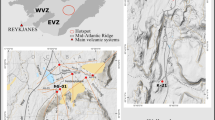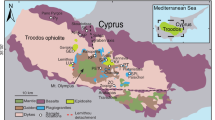Abstract
Fluids and melts liberated from subducting oceanic crust recycle lithophile elements back into the mantle wedge, facilitate melting and ultimately lead to prolific subduction-zone arc volcanism1,2. The nature and composition of the mobile phases generated in the subducting slab at high pressures have, however, remained largely unknown3,4,5,6,7. Here we report direct LA-ICPMS measurements of the composition of fluids and melts equilibrated with a basaltic eclogite at pressures equivalent to depths in the Earth of 120–180 km and temperatures of 700–1,200 °C. The resultant liquid/mineral partition coefficients constrain the recycling rates of key elements. The dichotomy of dehydration versus melting at 120 km depth is expressed through contrasting behaviour of many trace elements (U/Th, Sr, Ba, Be and the light rare-earth elements). At pressures equivalent to 180 km depth, however, a supercritical liquid with melt-like solubilities for the investigated trace elements is observed, even at low temperatures. This mobilizes most of the key trace elements (except the heavy rare-earth elements, Y and Sc) and thus limits fluid-phase transfer of geochemical signatures in subduction zones to pressures less than 6 GPa.
This is a preview of subscription content, access via your institution
Access options
Subscribe to this journal
Receive 51 print issues and online access
$199.00 per year
only $3.90 per issue
Buy this article
- Purchase on Springer Link
- Instant access to full article PDF
Prices may be subject to local taxes which are calculated during checkout


Similar content being viewed by others
References
Kushiro, K. in Magmatic Processes: Physicochemical Principles (ed. Mysen, B. O.) 165–181 (Special Publication No. 1, Geochemical Society, 1987)
Tatsumi, Y., Hamilton, D. L. & Nesbitt, R. W. Chemical characteristics of fluid phase released from a subducted lithosphere and origin of arc magmas: evidence from high-pressure experiments and natural rocks. J. Volcanol. Geotherm. Res. 29, 293–309 (1986)
Kelemen, P. B., Hanghj, K. & Greene, A. R. One view of the geochemistry of subduction-related magmatic arcs, with an emphasis on primitive andesite and lower crust. Treatise Geochem. 3, 593–659 (2004)
Johnson, M. C. & Plank, T. Dehydration and melting experiments constrain the fate of subducted sediments. Geochem. Geophys. Geosyst. 1, doi:10.1029/1999GC000014 (1999)
Hawkesworth, C. J., Turner, S. P., McDermott, F., Peate, D. W. & van Clasteren, P. U-Th isotopes in arc magmas: Implications for element transfer from the subducted crust. Science 276, 551–555 (1997)
Morris, J. D., Leeman, W. P. & Tera, F. The subducted component in island arc lavas: constraints from Be isotopes and B-Be systematics. Nature 344, 31–36 (1990)
Elliot, T., Plank, T., Zindler, A., White, W. & Bourdon, B. Element transport from slab to volcanic front at the Mariana arc. J. Geophys. Res. 102, 14991–15019 (1997)
Sigmarsson, O., Martin, H. & Knowles, J. Melting of a subducting oceanic crust from U-Th disequilibria in austral Andean lavas. Nature 394, 566–569 (1998)
Ryan, J. G., Morris, J., Tera, F., Leeman, W. P. & Tsvetkov, A. Cross-arc geochemical variations in the Kurile arc as a function of slab depth. Science 270, 625–627 (1995)
Morris, J. D. & Ryan, J. G. Subduction zone processes and implications for changing composition of the upper and lower mantle. Treatise Geochem. 2, 451–470 (2004)
Tatsumi, Y. & Eggins, S. Subduction Zone Magmatism (Frontiers in Earth Sciences, Blackwell Science, Cambridge, Massachusetts, 1995)
Kincaid, C. & Sachs, I. S. Thermal and dynamical evolution of the upper mantle in subduction zones. J. Geophys. Res. 102, 12295–12315 (1997)
Turner, S. & Hawkesworth, C. Constraints on flux rates and mantle dynamics beneath island arcs from Tonga-Kermadec lava geochemistry. Nature 389, 568–573 (1997)
Schmidt, M. W., Vielzeuf, D. & Auzanneau, E. Melting and dissolution of subducting crust at high pressures: the key role of white mica. Earth Planet. Sci. Lett. 228, 65–84 (2004)
Stalder, R., Ulmer, P., Thompson, A. B. & Günter, D. High pressure fluids in the system MgO-SiO2-H2O under upper mantle conditions. Contrib. Mineral. Petrol. 140, 607–618 (2001)
Shen, A. H. & Keppler, H. Direct observation of complete miscibility in the albite-H2O system. Nature 385, 710–712 (1997)
Baker, M. B. & Stolper, E. M. Determining the composition of high-pressure mantle melts using diamond aggregates. Geochim. Cosmochim. Acta 58, 2811–2827 (1994)
Kushiro, I. & Hirose, K. Experimental determination of composition of melt formed by equilibrium partial melting of peridotite at high pressures using aggregates of diamond grains. Proc. Jpn. Acad. 68, 63–68 (1992)
Schmidt, M. W. & Ulmer, P. A rocking multianvil: Elimination of chemical segregation in fluid-saturated high-pressure experiments. Geochim. Cosmochim. Acta 68, 1889–1899 (2004)
Kessel, R., Ulmer, P., Pettke, T., Schmidt, M. W. & Thompson, A. B. Experimental determination of phase relations and second critical endpoint in K-free eclogite-H2O at 4–6 GPa and 700–1400 °C. Earth Planet. Sci. Lett.(in the press)
Brenan, J. M., Shaw, H. F., Ryerson, F. J. & Phinney, D. L. Mineral-aqueous fluid partitioning of trace elements at 900 °C and 2.0 GPa: Constraints on the trace element chemistry of mantle and deep crustal fluids. Geochim. Cosmochim. Acta 59, 3331–3350 (1995)
Stalder, R., Foley, S. F., Brey, G. P. & Horn, I. Mineral-aqueous fluid partitioning of trace elements at 900–1200 °C and 3.0–5.7 GPa: New experimental data for garnet, clinopyroxene, and rutile, and implications for mantle metasomatism. Geochim. Cosmochim. Acta 62, 1781–1801 (1998)
Green, T. H., Blundy, J. D., Adam, J. & Yaxley, G. M. SIMS determination of trace element partition coefficients between garnet, clinopyroxene and hydrous basaltic liquids at 2–7.5 GPa and 1080–1200 °C. Lithos 53, 165–187 (2000)
Klemme, S., Blundy, J. D. & Wood, B. J. Experimental constraints on major and trace element partitioning during partial melting of eclogite. Geochim. Cosmochim. Acta 66, 3109–3123 (2002)
Brenan, J. M., Ryerson, J. F. & Shaw, H. F. The role of aqueous fluids in the slab-to-mantle transfer of boron, beryllium, and lithium during subduction: Experiments and models. Geochim. Cosmochim. Acta 62, 3337–3347 (1998)
Martin, H. Adakitic magmas: modern analogues of Archaean granitoids. Lithos 46, 411–429 (1999)
Schmidt, M. W. & Poli, S. Experimentally based water budgets for dehydrating slabs and consequences for arc magma generation. Earth Planet. Sci. Lett. 163, 361–379 (1998)
Fumagalli, P. & Poli, S. Experimentally determined phase relations in hydrous peridotites to 6.5 GPa and their consequences on the dynamics of subduction zones. J. Petrol. 46, 555–578 (2005)
Kerrick, D. M. & Connolly, J. A. D. Metamorphic devolatilization of subducted marine sediments and the transport of volatiles into the Earth's mantle. Nature 411, 293–296 (2001)
Holloway, J. R. & Domanik, K. J. Experimental synthesis and phase relations of phengitic muscovite from 6.5 to 11 GPa in a calcareous metapelite from the Dabie Mountains, China. Lithos 52, 51–77 (2000)
Yaxley, G. M. & Green, D. H. Experimental demonstration of refractory carbonate-bearing eclogite and siliceous melt in the subduction regime. Earth Planet. Sci. Lett. 128, 313–325 (1994)
Kessel, R., Ulmer, P., Pettke, T., Schmidt, M. W. & Thompson, A. B. A novel approach to determine high-pressure high-temperature fluid and melt compositions using diamond-trap experiments. Am. Mineral. 89, 1078–1086 (2004)
Author information
Authors and Affiliations
Corresponding author
Ethics declarations
Competing interests
Reprints and permissions information is available at npg.nature.com/reprintsandpermissions. The authors declare no competing financial interests.
Supplementary information
Supplementary Tables S1–S6
These six Supplementary Tables provide the concentrations of all phases (garnet, clinopyroxene, liquid) in each experiment, as well as their abundance. Also provided are the bulk partition coefficients of each element and its mobility. (XLS 93 kb)
Rights and permissions
About this article
Cite this article
Kessel, R., Schmidt, M., Ulmer, P. et al. Trace element signature of subduction-zone fluids, melts and supercritical liquids at 120–180 km depth. Nature 437, 724–727 (2005). https://doi.org/10.1038/nature03971
Received:
Accepted:
Issue Date:
DOI: https://doi.org/10.1038/nature03971
This article is cited by
-
Titanium isotopic fractionation during alkaline magma differentiation at St. Helena Island
Contributions to Mineralogy and Petrology (2024)
-
Supercritical fluids behave as complex networks
Nature Communications (2023)
-
Pervasive hydrous carbonatitic liquids mediate transfer of carbon from the slab to the subarc mantle
Communications Earth & Environment (2023)
-
Experimental production of K-rich metasomes through sediment recycling at the slab-mantle interface in the fore-arc
Scientific Reports (2023)
-
The evolution of diamond-forming fluids indicating a pre-kimberlitic metasomatic event in the mantle beneath the Mirny field (Siberian craton)
Contributions to Mineralogy and Petrology (2023)
Comments
By submitting a comment you agree to abide by our Terms and Community Guidelines. If you find something abusive or that does not comply with our terms or guidelines please flag it as inappropriate.



